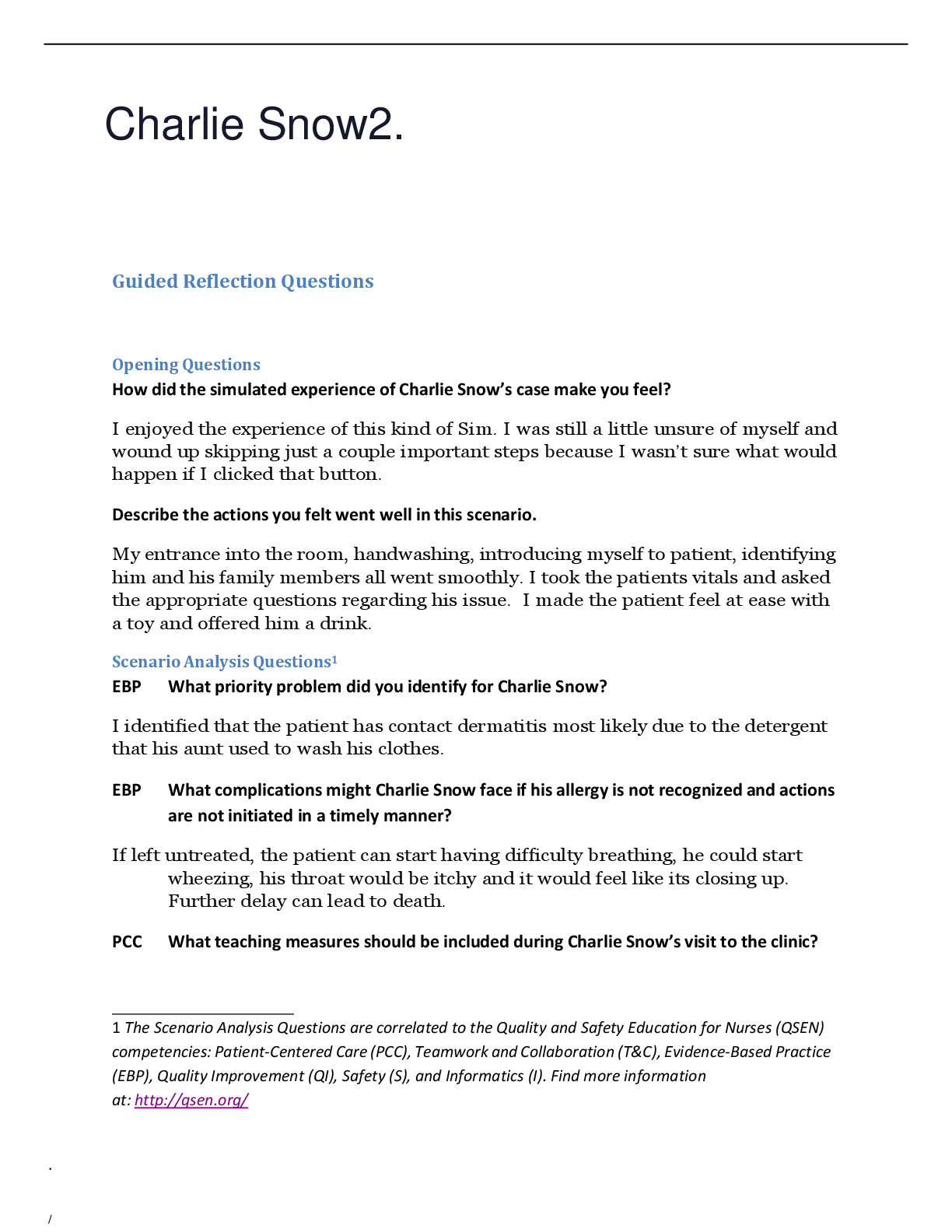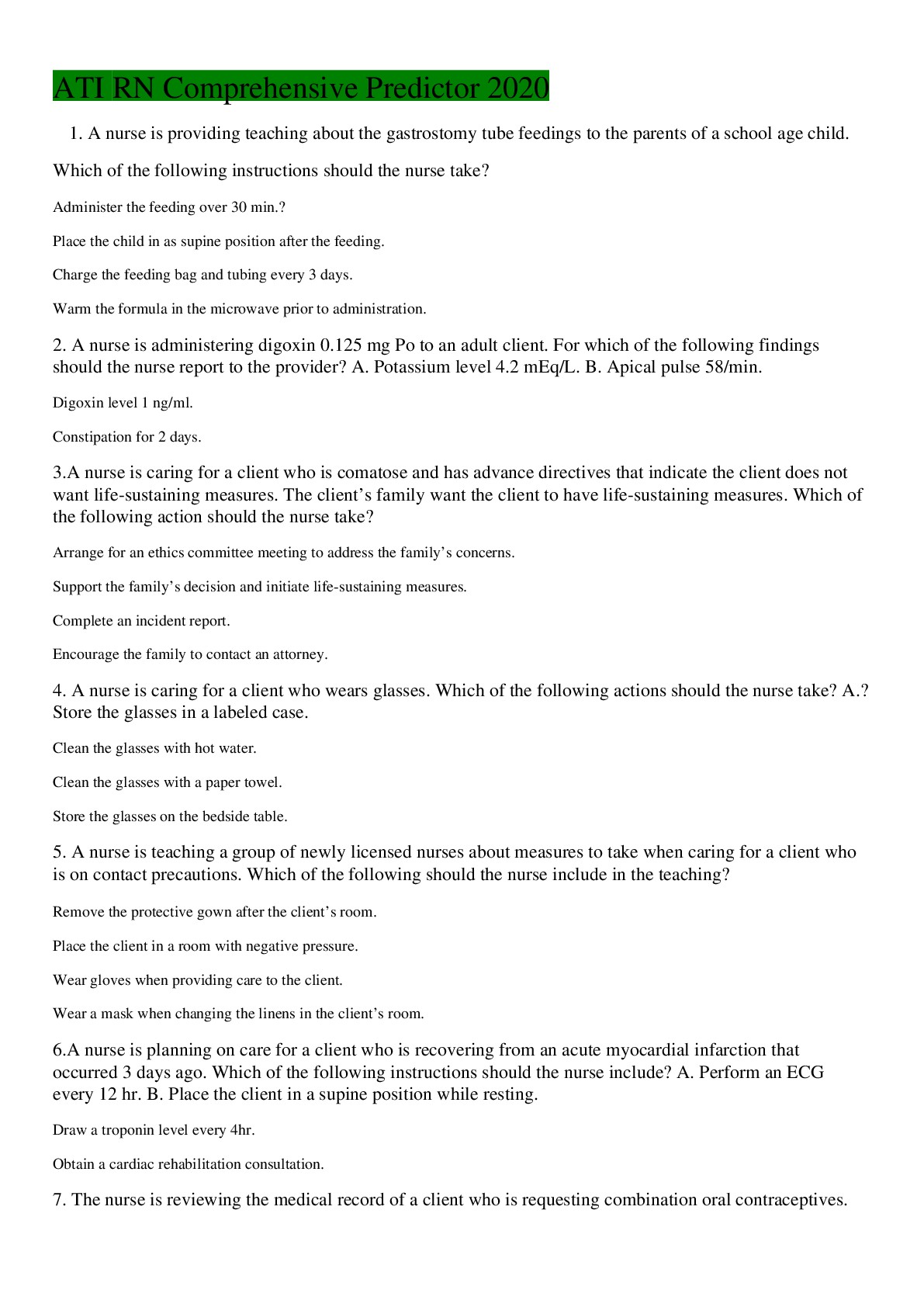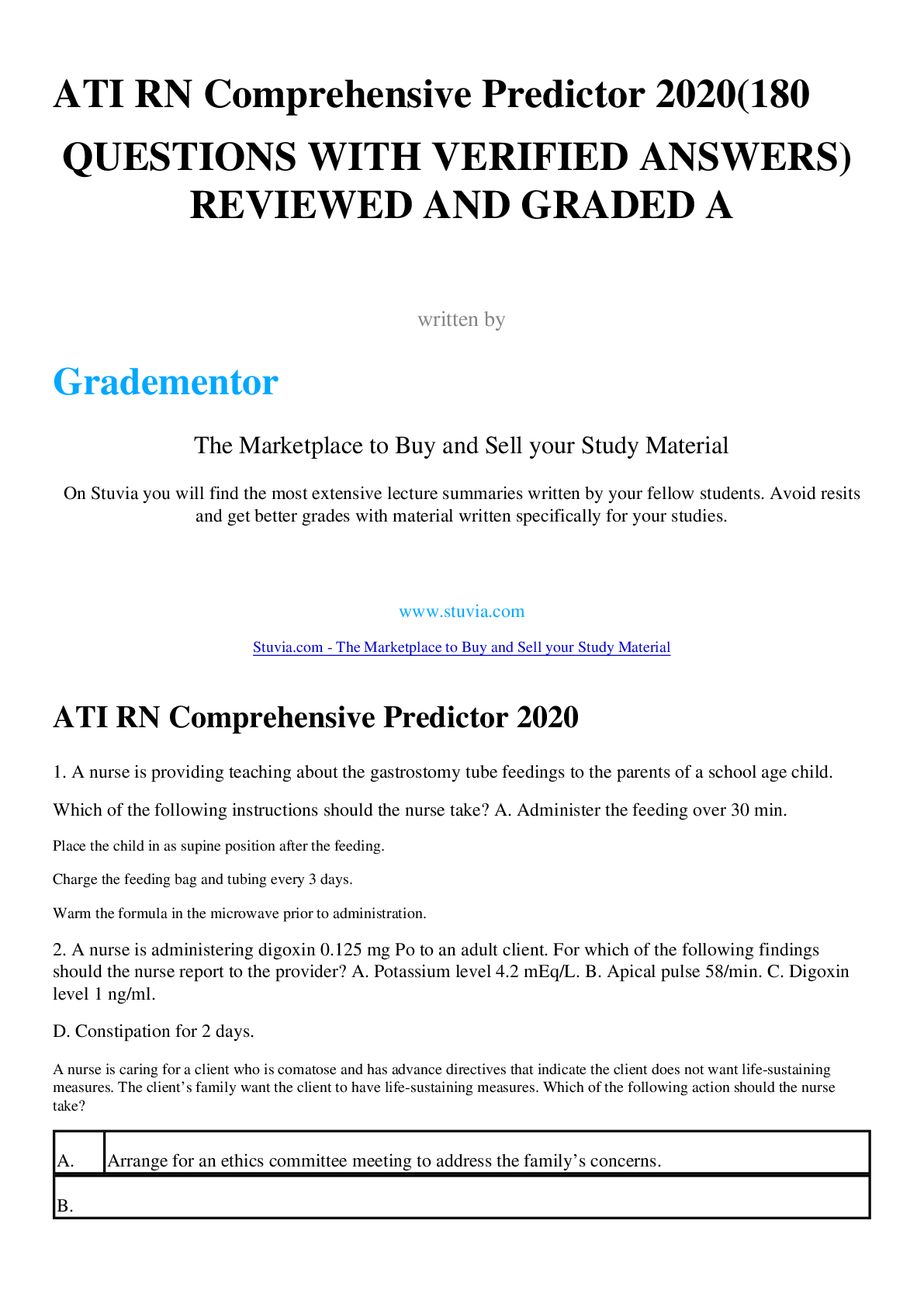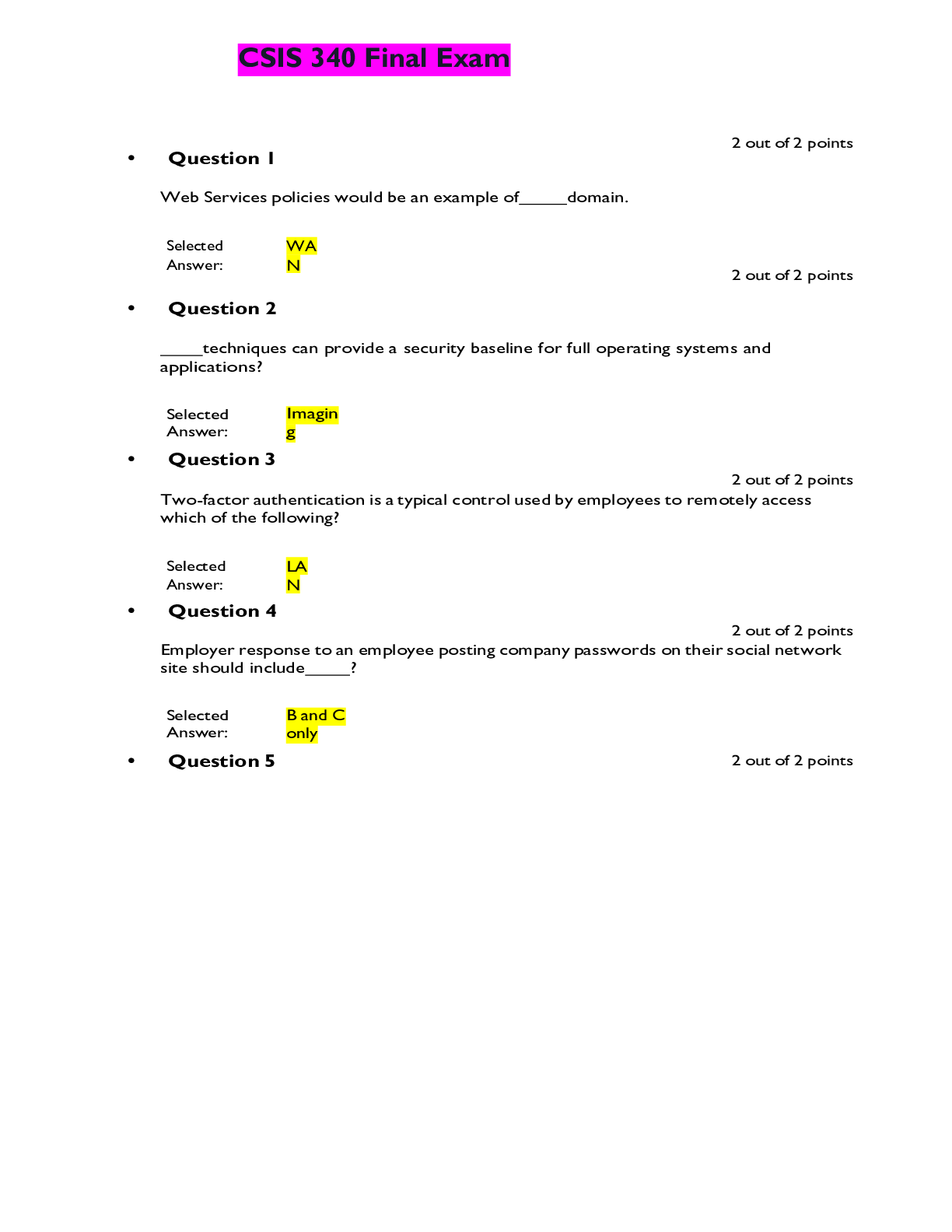*NURSING > EXAM > PediatricCase1_DA.,WELL EXPLAINED WITH VERIFIED ANSWERS 2021 LATEST GRADED A. (All)
PediatricCase1_DA.,WELL EXPLAINED WITH VERIFIED ANSWERS 2021 LATEST GRADED A.
Document Content and Description Below
Document your initial focused assessment of Jackson Weber. 1. ackson Weber is a 5- year-old Caucasian male. He was diagnosed with generalized tonic- 2. clonic seizures 2 years ago. Upon diagnosis,... Jackson's neurologist started him on oral 3. phenobarbital. Due to his seizure diagnosis my initial focused assessment was on his 4. neurological status, eye movements, and pupil reaction. 5. ackson Weber is a 5- year-old Caucasian male. He was diagnosed with generalized tonic- 6. clonic seizures 2 years ago. Upon diagnosis, Jackson's neurologist started him on oral 7. phenobarbital. Due to his seizure diagnosis my initial focused assessment was on his 8. neurological status, eye movements, and pupil reaction. 9. ackson Weber is a 5- year-old Caucasian male. He was diagnosed with generalized tonic- 10. clonic seizures 2 years ago. Upon diagnosis, Jackson's neurologist started him on oral 11. phenobarbital. Due to his seizure diagnosis my initial focused assessment was on his 12. neurological status, eye movements, and pupil reaction. 13. ackson Weber is a 5- year-old Caucasian male. He was diagnosed with generalized tonic- 14. clonic seizures 2 years ago. Upon diagnosis, Jackson's neurologist started him on oral 15. phenobarbital. Due to his seizure diagnosis my initial focused assessment was on his 16. neurological status, eye movements, and pupil reaction. Jackson Weber is a 5 year old Caucasian male. He was diagnosed with generalized tonic clonic seizure 2 years ago. Before seizure started I focused on neurological assessment include his eye movement and pupils as well as vital signs. After seizure I focused assessment was on his neurological status, eye movement, pupil reactions and respiratory rate as well because I gave him 100 % oxygen from a non breathing mask. 2. Identify and document key nursing diagnoses for Jackson Weber. Ineffective airway clearance and gas exchange r/t impaired breathing pattern aeb 02 sat < 85%, LOC, confusion and seizure activity Risk for injury r/t patient’s seizure activity 3. Referring to your feedback log, document the nursing care you provided and Jackson Weber’s response. 0:00 You introduced yourself. 0:08 You washed your hands. To maintain patient safety it is important to wash your hands as soon as you enter the room. 0:10 Child status - ECG: Sinus rhythm. Heart rate: 100. Pulse: Present. Blood pressure: 120/80 mmHg. Respiration: 13. Conscious state: Appropriate. SpO2: 99%. Temp: 36.8 C 1:10 Child status - ECG: Sinus rhythm. Heart rate: 100. Pulse: Present. Blood pressure: 117/79 mmHg. Respiration: 14. Conscious state: Appropriate. SpO2: 99%. Temp: 36.7 C 1:21 You identified the child. To maintain patient safety it is important that you quickly identify the child. 1:30 You identified the relatives. This is important, as the patient is below 18 years of age. 1:44 You asked the parent: Does he have any known allergies? The parent replied: 'No. I don't think so.' 2:10 Child status - ECG: Sinus rhythm. Heart rate: 100. Pulse: Present. Blood pressure: 118/80 mmHg. Respiration: 14. Conscious state: Appropriate. SpO2: 99%. Temp: 36.7 C 2:28 You attached the automatic noninvasive blood pressure (NIBP) measurement cuff. This will allow you to reassess the child continuously. 2:44 You measured the <Temperature>temperature<> in the ear. The temperature was 36.7 C. 2:52 You looked for normal breathing. He is breathing at 14 breaths per minute. The chest is moving equally. 3:10 Child status - ECG: Sinus rhythm. Heart rate: 100. Pulse: Present. Blood pressure: 117/79 mmHg. Respiration: 14. Conscious state: Appropriate. SpO2: 98%. Temp: 36.7 C 3:28 You assessed the pain level using the FACES scale. The child answered 0 on the FACES pain scale with a range of 0 to 5. 3:53 You assessed the child's IV. The site had no redness, swelling, infiltration, bleeding, or drainage. The dressing was dry and intact. This is correct. Assessing any IVs the child has is always important. 4:10 Child status - ECG: Sinus rhythm. Heart rate: 100. Pulse: Present. Blood pressure: 118/79 mmHg. Respiration: 14. Conscious state: Appropriate. SpO2: 98%. Temp: 36.7 C 4:28 You checked the eye movements. Extraocular movement was intact. 4:48 You checked the child's pupils and they were 4 mm and reactive. 5:10 You assessed the child's neurological status. 6:06 The child had a seizure. 6:06 Child status - ECG: Sinus rhythm. Heart rate: 102. Pulse: Present. Blood pressure: 120/81 mmHg. Respiration: 14. Conscious state: Unconscious. SpO2: 89%. Temp: 36.7 C 6:16 Child status - ECG: Sinus rhythm. Heart rate: 123. Pulse: Present. Blood pressure: 130/88 mmHg. Respiration: 4. Conscious state: Unconscious. SpO2: 88%. Temp: 36.7 C 6:43 You secured the patient to avoid injuries during seizures This is correct. 6:59 You sat the child up. 7:05 You put the child in the recovery position. Placing the child in the recovery position will help to remove the airway obstruction. 7:16 Child status - ECG: Sinus rhythm. Heart rate: 121. Pulse: Present. Blood pressure: 134/90 mmHg. Respiration: 7. Conscious state: Unconscious. SpO2: 84%. Temp: 36.8 C 7:33 The child's seizure stopped. 7:33 Child status - ECG: Sinus rhythm. Heart rate: 121. Pulse: Present. Blood pressure: 137/92 mmHg. Respiration: 18. Conscious state: Unconscious. SpO2: 85%. Temp: 36.8 C 7:39 You gave the child 100% oxygen from a nonrebreathing mask. This was part of your orders. 7:43 Child status - ECG: Sinus rhythm. Heart rate: 122. Pulse: Present. Blood pressure: 129/87 mmHg. Respiration: 29. Conscious state: Somnolent. SpO2: 85%. Temp: 36.8 C 7:46 You turned the oxygen on. 8:13 Child status - ECG: Sinus rhythm. Heart rate: 115. Pulse: Present. Blood pressure: 128/86 mmHg. Respiration: 24. Conscious state: Somnolent. SpO2: 89%. Temp: 36.7 C 8:16 You phoned the provider in order to discuss the patient. 9:11 Child status - ECG: Sinus rhythm. Heart rate: 110. Pulse: Present. Blood pressure: 122/82 mmHg. Respiration: 19. Conscious state: Somnolent. SpO2: 94%. Temp: 36.7 C 9:55 You checked the eye movements. The child was not able to cooperate. 10:11 You checked the child's pupils and they were 4 mm and reactive. It is reasonable to check the pupils here. 10:11 Child status - ECG: Sinus rhythm. Heart rate: 105. Pulse: Present. Blood pressure: 117/79 mmHg. Respiration: 18. Conscious state: Somnolent. SpO2: 97%. Temp: 36.7 C 10:26 You looked for normal breathing. He is breathing at 18 breaths per minute. The chest is moving equally. 11:02 You tried to provide patient education. The child was still under stress. This might not be the best time for patient education. 11:05 You provided education to the relative regarding the child's condition. This is correct. It is important to use every opportunity to provide education. 11:11 Child status - ECG: Sinus rhythm. Heart rate: 103. Pulse: Present. Blood pressure: 116/78 mmHg. Respiration: 17. Conscious state: Somnolent. SpO2: 98%. Temp: 36.7 C 11:42 You phoned the provider in order to discuss the patient. 12:11 Child status - ECG: Sinus rhythm. Heart rate: 103. Pulse: Present. Blood pressure: 117/79 mmHg. Respiration: 17. Conscious state: Somnolent. SpO2: 99%. Temp: 36.7 C 13:08 You checked the eye movements. 13:11 Child status - ECG: Sinus rhythm. Heart rate: 102. Pulse: Present. Blood pressure: 118/80 mmHg. Respiration: 17. Conscious state: Somnolent. SpO2: 99%. Temp: 36.7 C 13:25 You checked the child's pupils and they were 4 mm and reactive. 13:41 You looked for normal breathing. He is breathing at 17 breaths per minute. The chest is moving equally. 14:11 Child status - ECG: Sinus rhythm. Heart rate: 102. Pulse: Present. Blood pressure: 121/81 mmHg. Respiration: 17. Conscious state: Somnolent. SpO2: 99%. Temp: 36.7 C 14:25 You measured the <Temperature>temperature<> in the ear. The temperature was 36.7 C. 15:11 Child status - ECG: Sinus rhythm. Heart rate: 102. Pulse: Present. Blood pressure: 119/80 mmHg. Respiration: 17. Conscious state: Somnolent. SpO2: 99%. Temp: 36.7 C 15:13 You placed a <Nasal_oxygen>nasal oxygen cannula.<> Supplemental oxygen therapy is not required according to current orders. The current order is to maintain an oxygen saturation above 93% 15:58 You looked for normal breathing. He is breathing at 17 breaths per minute. The chest is moving equally. 16:11 Child status - ECG: Sinus rhythm. Heart rate: 102. Pulse: Present. Blood pressure: 117/79 mmHg. Respiration: 17. Conscious state: Somnolent. SpO2: 99%. Temp: 36.7 C 16:21 You measured the <Temperature>temperature<> in the ear. The temperature was 36.7 C. 16:42 You checked the child's pupils and they were 4 mm and reactive. 17:04 You phoned the provider in order to discuss the patient. 17:11 Child status - ECG: Sinus rhythm. Heart rate: 102. Pulse: Present. Blood pressure: 120/80 mmHg. Respiration: 17. Conscious state: Somnolent. SpO2: 99%. Temp: 36.7 C 18:11 Child status - ECG: Sinus rhythm. Heart rate: 103. Pulse: Present. Blood pressure: 117/79 mmHg. Respiration: 17. Conscious state: Somnolent. SpO2: 99%. Temp: 36.7 C 18:17 A patient handoff was performed. 4. Document the teaching that you would provide for Jackson Weber and his mother before discharge. • I thaught what the meaning of seizure. o Seizures occur as a result of abnormal, excessive electrical activity within the brain. While some seizures are idiopathic, others occur as a result of trauma, infection, hypoglycemia, endocrine dysfunction, toxins, or tumors. Accompanying signs and symptoms can include loss of consciousness, jerking movements, loss of bowel and bladder control, and altered breathing pattern. • I explained his mother/him how to manage of seizures. o Management of seizures includes antiepileptic medications, safety precautions. During a seizure, care of the patient includes: maintaining airway patency, ensuring safety including the use of seizure pads according to local recommandations, avoiding rask of aspiration, administering medications, and providing emotional support to the family. Some patients needs help from social work for optimal treatment. Medical alert bracelets should be worn by all children with a history of seizures. A history of seizures should not confine a child to a sedentary life, but extra supervision is needed while swimming and during activities such as rock climbing, and it is essential that helmets and padding be worn while riding bicycles. Risk factors for exacerbations include noncompliance with medication regimen, nontherapeutic drug levels, infection, head injury, electrolyte imbalances, and metabolic disorders. • Advised the patient to participate in a seizure program for children at this age • Educated pt’s mother about phonebarbital and side and adverse effects of medication 5. Document your handoff report in the situation-background-assessment-recommendation (SBAR) format to communicate what further care Jackson Weber needs. Situation: Jackson Weber 5 y/o male. He had a tonic-clonic seizure. He remained free from harm. IV site dry, intact and no redness with order solution running. Talked with the provider about his situation. HCP saw the patient. Phenobarbital 300 mg IV loadinding dose. He is on oral Pheno BID. . Given 100% oxygen from a nonrebreathing mask. He came back to normal. He had a seizure Patient is in postictal state. Background: Jackson Weber is a 5 y/o Caucasian male. He was diagnosed with generalized tonic- clonic seizures 2 years ago. He has not been seen by his neurologist in 15 months due to his mother’s work schedule. Assessment: His neurological assessment was intact include eye movement and pupils. No pain reported. Has IV infusing in the left arm D5NS + 20 mEq kCl at 58 ml/hr. No redness swollen or tenderness. He began to seizure, he was placed in the recovery position to help to remove the airway obstruction. No injury noted. Given 100% oxygen from a nonbreathing mask and HCP called. Postictal state, not able to cooperate. PERRLA. Respiratory rate was 18 bpm. His labs show low phenobarbital. 50 mg phenobarbital administered PO. Recommendation: He needs to be monitored carefully. Continue to assess pt’s VS and neuro. Ask for lab order to check levels of Phenobarbital and administer it as ordered. Patient’s mother need to be educated on management of seizures and also medication [Show More]
Last updated: 2 years ago
Preview 1 out of 10 pages

Buy this document to get the full access instantly
Instant Download Access after purchase
Buy NowInstant download
We Accept:

Reviews( 0 )
$16.00
Can't find what you want? Try our AI powered Search
Document information
Connected school, study & course
About the document
Uploaded On
May 11, 2021
Number of pages
10
Written in
Additional information
This document has been written for:
Uploaded
May 11, 2021
Downloads
0
Views
64


























